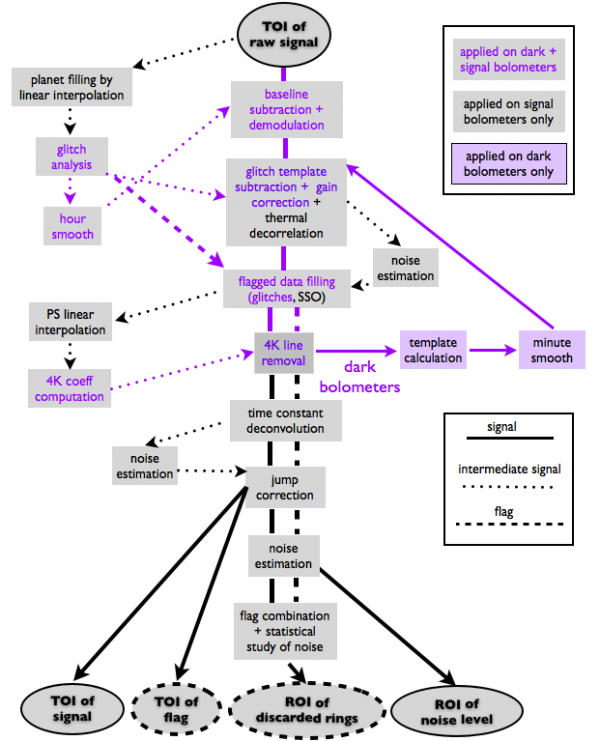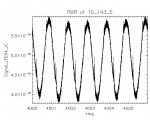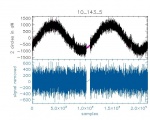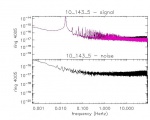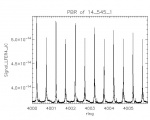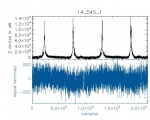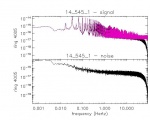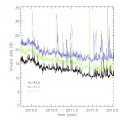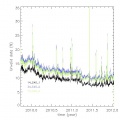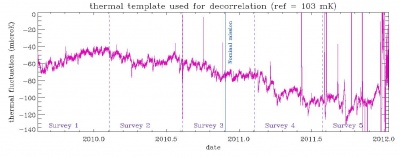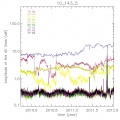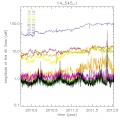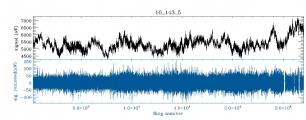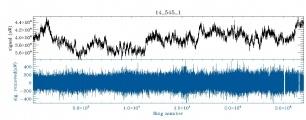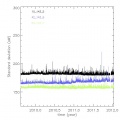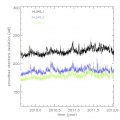TOI processing
This Section is kept short as this Planck release does not contain TOIs. The main information in the HFI processing paper is not duplicated here.
Contents
Overview[edit]
We describe here the how the TOIs are processed in order to be used for map production. We do not repeat the general features of the pipeline which are given in the HFI Data Processing article (REF). Here we give complementary explanations on some details. The TOI of each bolometer is processed independently of the other bolometers, so as to keep the noise properties as uncorrelated as possible. The processing involves modifying the TOI itself for what concerns the conversion to absorbed power and the correction of glitch tails. It also adds a flag TOI that masks the TOI samples that are not to be projected on maps for various reasons.
Input TOI[edit]
The input TOI consists in the AC modulated voltage output of the readout of each bolometer. The input has previously been decompressed, and converted from internal digital units to voltage via a constant factor. The TOI has a regular sampling at the acquisition frequency of facq=180.373700+-0.000050 Hz. There are almost no missing data in the TOIs, except for few hundred samples of 545 and 857GHz TOIs which are lost in the on-board compression due to saturation on the Galactic Center crossings.
General Pipeline Structure[edit]
The figure on the right shows how the initial ccTOI is transformed and how flags are produced:
Output TOIs and products[edit]
A TOI of clean calibrated samples (ccTOI) and a combined flag TOI (fTOI) are the outputs of the processing. The ccTOI is calibrated so as to represent the instantaneous power absorbed by the detector up to a constant (which will be determined by the map-making destriper). It is worth mentioning how the ccTOI is changed with respect to the input TOI, beyond the harmless constant conversion factor from voltage to absorbed power. The demodulation stage allows to get the demodulated bolometer voltage. The non-linearity correction is a second-order polynomial correction based on the physical but static bolometer model. In order to avoid too much masking after glitches, a glitch tail is subtracted after an occurrence of a glitch in the TOI. The 4K cooler lines noise is substituted at a series of 9 single temporal frequencies. Finally, the temporal response of the bolometer is deconvolved. This affects mostly the high-temporal frequency part of the TOI, although a small but significant low frequency (the long time response) tail is corrected too. Although flagged samples are not projected, their value influences the valid samples somehow. Hence interpolation procedures introduce some indirect modifications of the TOI. The flag TOI is a combination a dozen flags with an OR logic. Only unflagged data are projected. The exhaustive list of flags is given here: CompressionError, NoData, SSO, UnstablePointing, Glitch, BoloPlateFluctuation, RTS, Jump, PSBab. A complete qualification of the data is obtained at the ring level. If the TOI shows an anomalous behaviour on a given ring, this ring is discarded from projection. A special production of TOIs is also made as an input to the beam analysis with Mars, Jupiter and Saturn.
Examples of clean TOIs[edit]
Samples of PBR, TOIs, and PSDs of all detectors are shown in this file
Trends in the output processing variables[edit]
Here we intend to show the trend of the systematic effects that are dealt with in the TOI processing. The full impact of each of them is analyzed in HFI-Validation.
ADC baseline[edit]
The following figure shows the ADC baseline which is used prior to demodulation (a constant offset is removed for clarity). This baseline is obtained by smoothing on an hour block average the undemodulated TOI on unflagged samples.
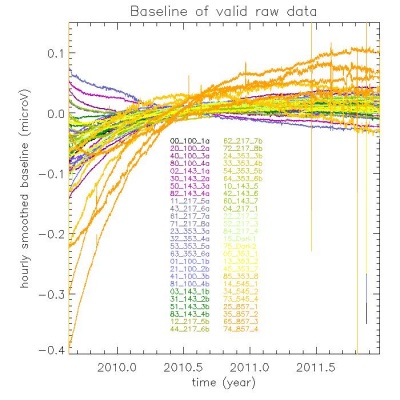
Glitch statistics[edit]
The glitch rate per channel is shown in this figure. For details, see copap.
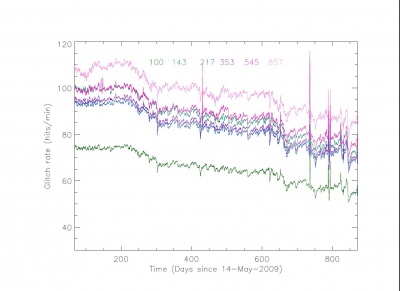
The percentage of flagged data (mostly due to Cosmic Rays) at the ring level is shown in these examples. No smoothing was applied. Only valid rings are shown.
- Percentage of flagged data
The complete set of plots is here
Thermal template for decorrelation[edit]
A simple linear decorrelation is performed using the 2 dark bolometers as a proxy of the bolometer plate temperature. Coupling coefficients were measured during the CPV phase.
4K cooler lines variability[edit]
The amplitude of the nine 4K cooler lines in aW at 10, 20, 30, 40, 50, 60, 70, 80 and 17 Hz is shown for 2 bolometers in the following figures. The trend is smoothed over 31 ring values after having discarded measurements done at a ring which is discarded for all bolometers.
- Amplitude of the nine 4K cooler lines
The 4K cooler line coefficients of all bolometers are shown in this file
jump correction[edit]
A piecewise constant value is removed to the TOI if a jump is detected. See a jump example in this figure:
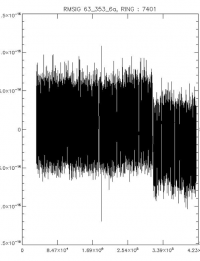
The number of jumps per day (all bolometers included) is shown in this figure:
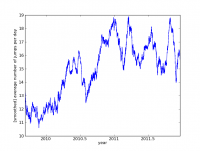
The jumps are uncorrelated from bolometer to bolometer. The total number of jumps detected in the nominal and full mission is shown here:
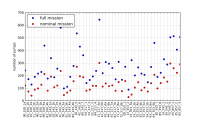
Trends in noise and signal[edit]
- Signal (top) and noise (bottom) smoothed at 1 minute. All values falling in a discarded ring are not plotted.
The smooth TOIs of all detectors are shown in this file
Noise stationarity[edit]
This is not the final version but gives a good idea of power spectra at the detector level of rmsigTOIs. All PSDs can be seen in this file
The standard deviation per ring corrected by ring duration bias is given here, one per bolometer using only valid rings. No smoothing is applied (except a 31-point smoothing for the 545 and 857 GHz channels) but values for rings discarded for all bolometers are not used. The standard deviation is computed on samples valid for map-making which are also not affected by the Galaxy or the point-sources using the usual flags. Two examples are given here.
- Standard deviation per ring
The full series of plots is here:
Standard deviation of rmsig TOIs at the ring level
Note the presence for 3 bolometers of a two-level noise system. No correction can be done for that effect. See one example here:
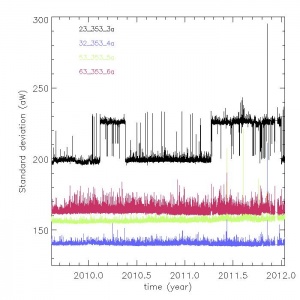
An example of the higher order statistics which are used to unveil rings affected by RTS problems.
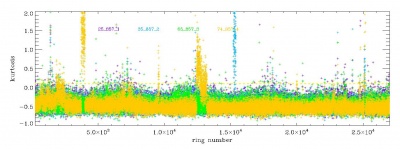
Anomalous rings[edit]
Some rings are thus discarded (flagged) from further use (beam making, map making) by using these ring statistics (see HFI data processing paper REF). For each statistics, we compare each ring value to the ring values averaged (RVA) over all rings. We also define the modified standard deviation (MSD) of a ring quantity as the standard deviation of that quantity over the rings that deviate by less than five nominal standard deviations. This truncation is necessary to be robust against extreme deviant rings.
More specifically, these are the full criteria (with the OR logic) to decide whether a ring is discarded:
- if |mean-median| deviates from the RVA by more than fifteen times the MSD.
- if the standard deviation deviates from the RVA by more than -5 times the MSD (all cases corresponding to almost empty rings) and +15 times the MSD.
- if the Kolmogorov-Smirnov test deviates from the RVA by more than 15 times the MSD.
- if the ring duration is outside some definite bounds. Bounds are 25 min and 90 min.
Once the list of discarded rings is done per bolometer, a common list of discarded rings can be produced for all bolometers (by using discarded rings for at least half the bolometers). See the following table.
Furthermore, an isolated valid ring stuck between two discarded rings becomes discarded as well.
Table of common discarded rings (v47, 240-21890) to be updated to v53, nominal mission.
| Cause | ring number |
|---|---|
| manoeuvre | 304 1312 3590 3611 3642 3922 4949 6379 8456 11328 |
| Sorption Cooler Switchover | 11149 11150 11151 11152 |
| Rings too long | 440 474 509 544 897 898 3589 13333 14627 14653 |
| fully flagged as unstable | 14628 14654 14842 16407 18210 |
| common jump | 7665 |
| solar flare | 20451 20452 20453 20454 20455 20456 |
| definition | Operational day # | Date | HFI ring # | pointing-IDs |
|---|---|---|---|---|
| Launch / first HFI data | - | 14/05/2009 13:12:00 / 14/05/2009 14:20:18 | - | - |
| CPV phase | 1 - 90 | 14/05/2009 14:20:18 - 12/08/2009 14:13:44 | 0 - 239 | not significant |
Flag description[edit]
Input flags[edit]
These flags are used as inputs to the TOI processing
- The point-source flag (PSflag):
An earlier version of HFI point-source catalog is read back into a flag TOIs, at a given frequency. In practice, 5 sigma sources are masked within a radius of 1.3 FWHM (9, 7, 5, 5, 5, 5 arcmin at 100,143,217,353,545,857 GHz) TBC.
- the galactic flag (Galflag):
An earlier version of HFI maps is thresholded and apodized. The produced masks are read into flag TOIs. The retained threshold corresponds to a sky coverage of respectively 70, 70, 80, 90, 90, 90% at 100,143,217,353,545,857 GHz.
- Solar System Object flag
For the TOI flag, Mars, Jupiter, Saturn are flagged up to a radius of NbBeam= 2,3,3,4,4,4 times the fiducial SSO_FWHM with SSO_FWHM= 9, 7, 5, 5, 5, 5 arcmin at 100,143,217,353,545,857 GHz.
As an input to planet mask for maps, Mars, Jupiter, Saturn are flagged with a radius computed as a coefficient depending on the planet (Factor_per_source) times NbBeam times SSO_FWHM, with Factor_per_source = 1.1, 2.25, 1.25 for Mars, Jupiter, Saturn respectively and NbBeam = 2.25, 4.25, 4.0, 5.0,.6.0, 8.0 at 100, 143, 217, 353, 545, 857 GHz. This flag is called SSOflag4map.
A small trailing tail is added to the mask to take into account the non-deconvolution of the planet signal which has been replaced by background values. The width of that tail is 10 % of the main flag diameter. The number of samples which are additionnaly flagged are the Factor_per_Source times AddSNafter with 10, 30, 20, 20, 30, 40 samples at 100, 143, 217, 353, 545, 857 GHz.
Uranus and Neptune together with detected asteroids are masked by HFI. They are masked at the TOI level using an exclusion radius of 1.5 SSO_FWHM. At 857 GHz, 24 asteroids have been detected with HFI : 1Ceres, 2Pallas, 3Juno, 4Vesta, 7Iris, 8Flora, 9Metis, 10Hygiea, 11Parthenope, 12Victoria, 13Egeria, 14Irene, 15Eunomia, 16Psyche, 18Melpomene, 19Fortuna, 20Massalia, 29Amphitrite, 41Daphne, 45Eugenia, 52Europa, 88Thisbe, 704Interamnia, 324Bamberga.
Output flags[edit]
A FlagTOIproc is produced by the TOIprocessing. It marks measurements which are not reliable for ny of the following reasons :
- gap (no valid input data), enlarged by one sample on each side. It flags less than 0.00044% (resp. 0.00062%) of the nominal (resp. complete) mission. It is equivallen to less thena 3 (resp. 8) minutes of data.
- glitch : samples where the signal from a cosmic ray hit dominates the sky signal at more than 3 $\sigma$ are discarded.
- jump as 100 samples are flagged around the computed position of the jump to take into account the error on this position.
With and without point-sources, identical to a and b PSBs.
Flags produced for the map making :
- UnstablePointing Flag OR FlagTOIproc OR SSOflag4map OR SSOflag seen
- FlagTOIproc = glitch OR jump OR flag thermal template
- PSB flag glitch = flag glitch A OR flag glitch B
Flag used in the destriping: same + point-source flag
(Planck) High Frequency Instrument
Solar System Object
random telegraphic signal
analog to digital converter
Calibration and Performance Verification
sudden change of the baseline level inside a ring
Full-Width-at-Half-Maximum
To be confirmed
